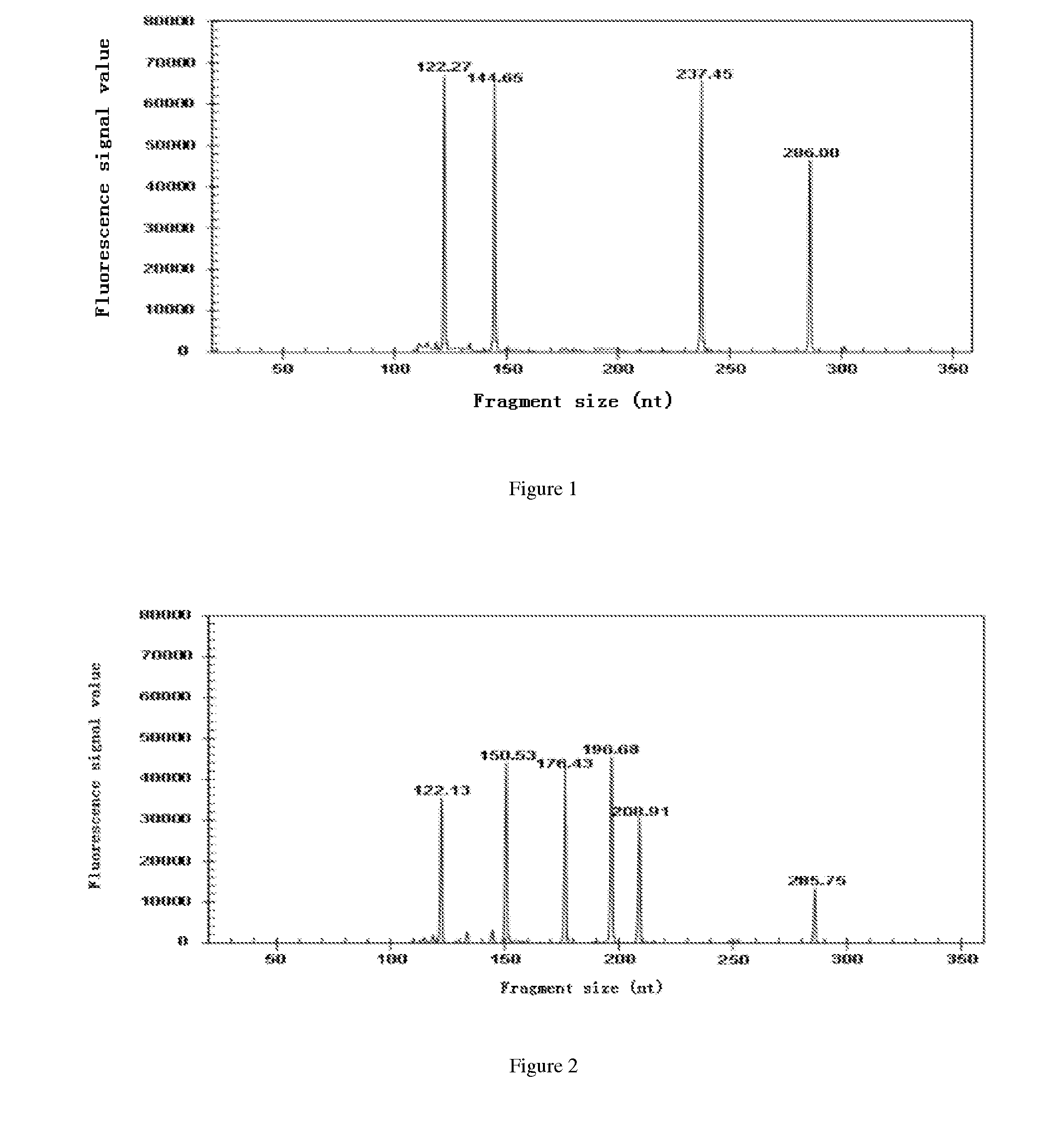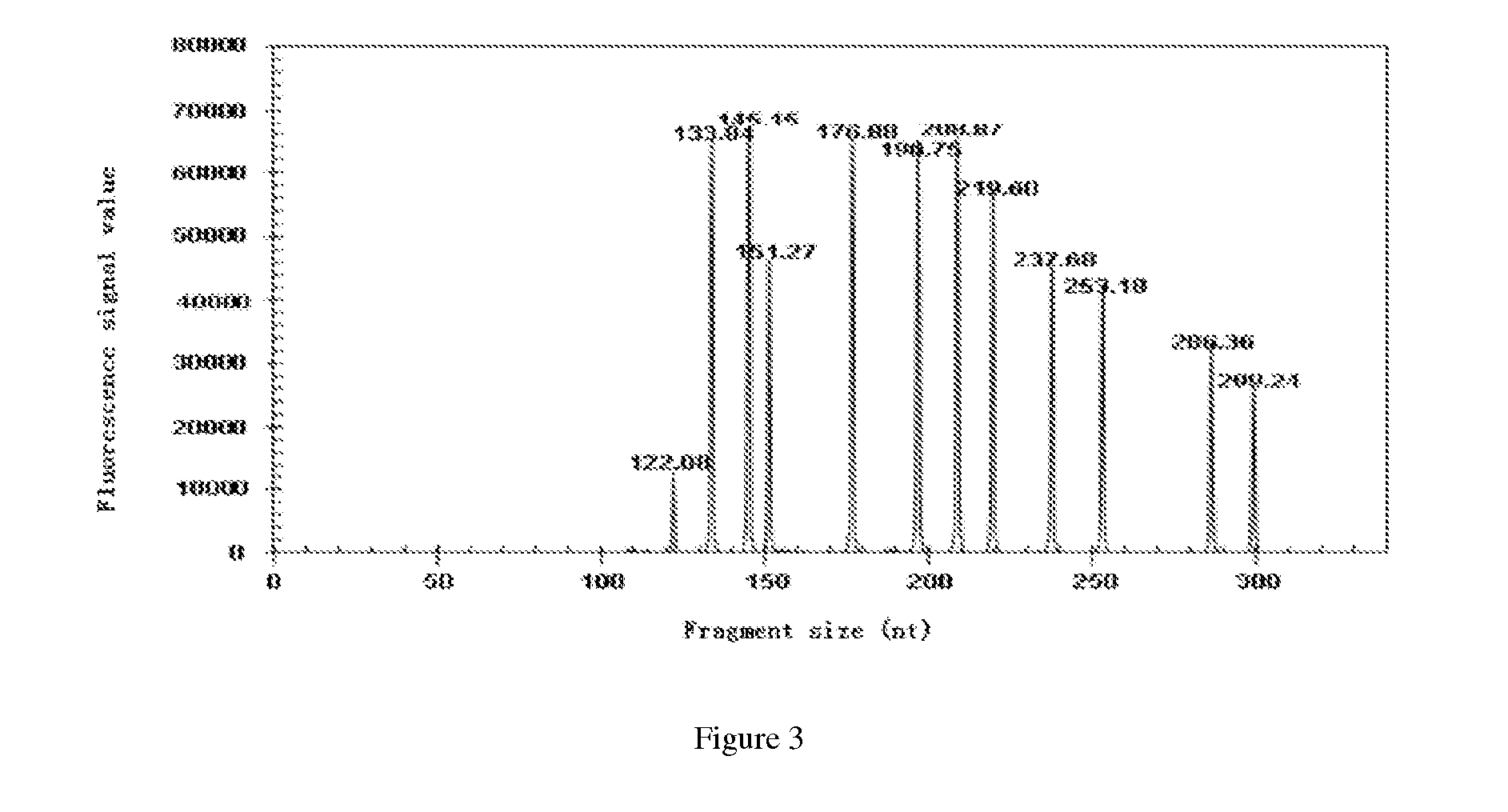GeXP Detection Kits for Identification of 11 Kinds of Duck Virus Diseases
a technology of duck virus and detection kits, applied in the field of biotechnology, can solve the problems of limiting the development of duck breeding, increasing the incidence of duck communicable virus diseases, and complicated operation of duck breeding
- Summary
- Abstract
- Description
- Claims
- Application Information
AI Technical Summary
Benefits of technology
Problems solved by technology
Method used
Image
Examples
example 2
Detection for the Specificity of Primer Pairs
I. Preparation of Templates
[0064]1. Extraction of Virus RNA and Acquisition of cDNA
[0065]With DNA / RNA Extraction Kit (purchased from TransGen Biotech Co. Ltd., catalog number is ER201), according to kit instructions, RNA of the following virus was extracted respectively (with samples obtained from duck embryo allantoic fluid which were negative for the following virus as negative control samples): avian influenza virus strains: Duck / HK / 717 / 79-d1 (subtype H1N3), Duck / HK / 77 / 76 (subtype H2N3), Duck / HK / 526 / 79 / 2B (subtype H3N6), Duck / HK / 668 / 79 (subtype H4N5), Duck / HK / 531 / 79 (subtype H6N8), Turkey / ont / 6118 / 68 (subtype H8N4), Duck / Guangxi / 1 / 00 (subtype H9N2), Duck / HK / 876 / 80 (subtype H10N3), Duck / HK / 661 / 79 (subtype H11N3), Duck / HK / 862 / 80 (subtype H12N5), Gull / MD / 704 / 77, (subtype H13N5); duck hepatitis virus, duck Tembusu virus, Newcastle disease virus, Muscovy duck reovirus.
2) Acquisition of cDNA
[0066]The RNA samples obt...
example 3
Detection for the Sensitivity of Primer Pairs
I. Preparation of Monoclonal Plasmid Standard and Subtype H7 of Avian Influenza Virus Both Containing Target Gene
[0119]With cDNA or DNA samples of subtype H5 of Avian influenza virus Duck / HK / 313 / 78 (subtype H5N3), subtype H7 of Avian influenza virus Duck / HK / 47 / 76 (subtype H7N2), subtype H9 of Avian influenza virus Duck / Guangxi / 1 / 00 (subtype H9N2), duck hepatitis virus, duck enteritis virus, duck Tembusu virus, Newcastle disease virus, egg drop syndrome virus, Muscovy duck reovirus, Muscovy duck parvovirus and duck circovirus as templates, full-sized cDNAs or DNA fragments of gene M of avian influenza virus, gene HA of subtype H5 of avian influenza virus, gene HA of subtype H7 of avian influenza virus, gene HA of subtype H9 of avian influenza virus, gene of region 5′ UTR of duck hepatitis virus, gene UL6 of duck enteritis virus, gene E of duck Tembusu virus, gene L of Newcastle disease virus, gene penton of egg drop syndrome virus, gene SI...
example 4
The Accuracy of Detection with Primer Pairs
[0123]I. The Accuracy of Detection with the Mixture of 12 Primer Pairs
[0124]cDNA samples of subtype H5 of avian influenza virus Duck / HK / 313 / 78 (subtype H5N3) and subtype H7 of avian influenza virus Duck / HK / 47 / 76 (H7N2 subtype) which were both identified by HA gene sequencing were sampled, subtype H9 of avian influenza virus Duck / Guangxi / 1 / 00 (H9N2 type), duck hepatitis virus, duck enteritis virus, duck Tembusu virus, Newcastle disease virus, egg drop syndrome virus, Muscovy duck reovirus, Muscovy duck parvovirus and duck circovirus which were identified with common experimental methods, such as: virus isolation, hemagglutination inhibition test, neutralization test etc (cDNA or DNA were extracted with the method used in step I of Example 2) were sampled. cDNA or DNA samples of the above single pathogen, cDNA or DNA samples simulating clinical infection with the above pathogens, mixed template of cDNA or DNA samples of the above pathogens we...
PUM
| Property | Measurement | Unit |
|---|---|---|
| temperature | aaaaa | aaaaa |
| concentration | aaaaa | aaaaa |
| agarose gel electrophoresis | aaaaa | aaaaa |
Abstract
Description
Claims
Application Information
 Login to View More
Login to View More - R&D
- Intellectual Property
- Life Sciences
- Materials
- Tech Scout
- Unparalleled Data Quality
- Higher Quality Content
- 60% Fewer Hallucinations
Browse by: Latest US Patents, China's latest patents, Technical Efficacy Thesaurus, Application Domain, Technology Topic, Popular Technical Reports.
© 2025 PatSnap. All rights reserved.Legal|Privacy policy|Modern Slavery Act Transparency Statement|Sitemap|About US| Contact US: help@patsnap.com


